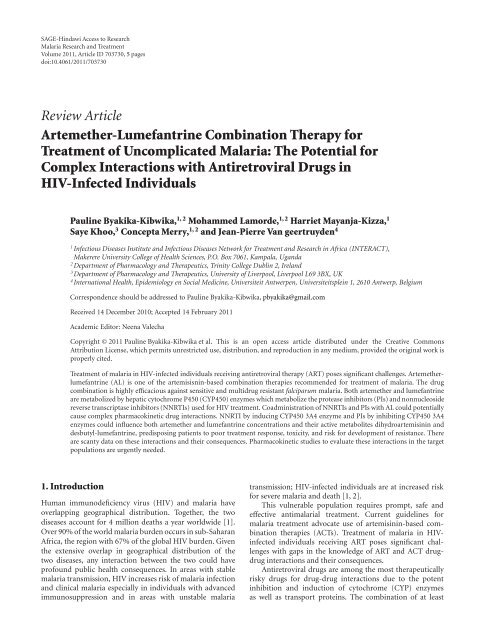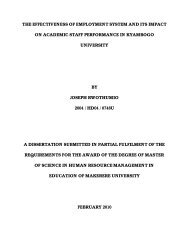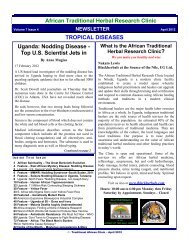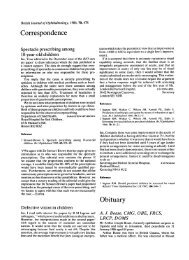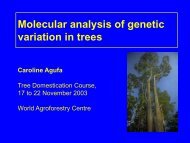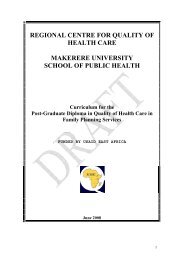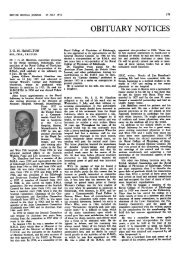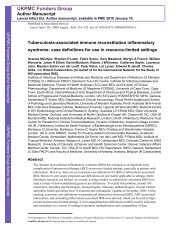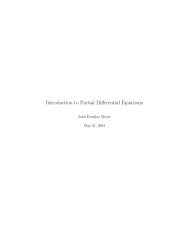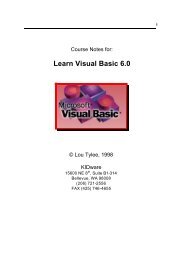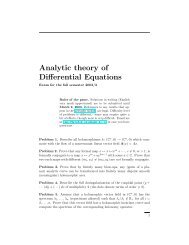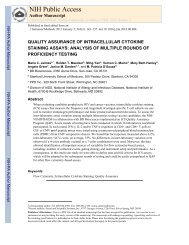Artemether-Lumefantrine Combination Therapy for Treatment of ...
Artemether-Lumefantrine Combination Therapy for Treatment of ...
Artemether-Lumefantrine Combination Therapy for Treatment of ...
You also want an ePaper? Increase the reach of your titles
YUMPU automatically turns print PDFs into web optimized ePapers that Google loves.
SAGE-Hindawi Access to Research<br />
Malaria Research and <strong>Treatment</strong><br />
Volume 2011, Article ID 703730, 5 pages<br />
doi:10.4061/2011/703730<br />
Review Article<br />
<strong>Artemether</strong>-<strong>Lumefantrine</strong> <strong>Combination</strong> <strong>Therapy</strong> <strong>for</strong><br />
<strong>Treatment</strong> <strong>of</strong> Uncomplicated Malaria: The Potential <strong>for</strong><br />
Complex Interactions with Antiretroviral Drugs in<br />
HIV-Infected Individuals<br />
Pauline Byakika-Kibwika, 1, 2 Mohammed Lamorde, 1, 2 Harriet Mayanja-Kizza, 1<br />
Saye Khoo, 3 Concepta Merry, 1, 2 and Jean-Pierre Van geertruyden 4<br />
1 Infectious Diseases Institute and Infectious Diseases Network <strong>for</strong> <strong>Treatment</strong> and Research in Africa (INTERACT),<br />
Makerere University College <strong>of</strong> Health Sciences, P.O. Box 7061, Kampala, Uganda<br />
2<br />
Department <strong>of</strong> Pharmacology and Therapeutics, Trinity College Dublin 2, Ireland<br />
3 Department <strong>of</strong> Pharmacology and Therapeutics, University <strong>of</strong> Liverpool, Liverpool L69 3BX, UK<br />
4<br />
International Health, Epidemiology en Social Medicine, Universiteit Antwerpen, Universiteitsplein 1, 2610 Antwerp, Belgium<br />
Correspondence should be addressed to Pauline Byakika-Kibwika, pbyakika@gmail.com<br />
Received 14 December 2010; Accepted 14 February 2011<br />
Academic Editor: Neena Valecha<br />
Copyright © 2011 Pauline Byakika-Kibwika et al. This is an open access article distributed under the Creative Commons<br />
Attribution License, which permits unrestricted use, distribution, and reproduction in any medium, provided the original work is<br />
properly cited.<br />
<strong>Treatment</strong> <strong>of</strong> malaria in HIV-infected individuals receiving antiretroviral therapy (ART) poses significant challenges. <strong>Artemether</strong>lumefantrine<br />
(AL) is one <strong>of</strong> the artemisisnin-based combination therapies recommended <strong>for</strong> treatment <strong>of</strong> malaria. The drug<br />
combination is highly efficacious against sensitive and multidrug resistant falciparum malaria. Both artemether and lumefantrine<br />
are metabolized by hepatic cytochrome P450 (CYP450) enzymes which metabolize the protease inhibitors (PIs) and nonnucleoside<br />
reverse transcriptase inhibitors (NNRTIs) used <strong>for</strong> HIV treatment. Coadministration <strong>of</strong> NNRTIs and PIs with AL could potentially<br />
cause complex pharmacokinetic drug interactions. NNRTI by inducing CYP450 3A4 enzyme and PIs by inhibiting CYP450 3A4<br />
enzymes could influence both artemether and lumefantrine concentrations and their active metabolites dihydroartemisinin and<br />
desbutyl-lumefantrine, predisposing patients to poor treatment response, toxicity, and risk <strong>for</strong> development <strong>of</strong> resistance. There<br />
are scanty data on these interactions and their consequences. Pharmacokinetic studies to evaluate these interactions in the target<br />
populations are urgently needed.<br />
1. Introduction<br />
Human immunodeficiency virus (HIV) and malaria have<br />
overlapping geographical distribution. Together, the two<br />
diseases account <strong>for</strong> 4 million deaths a year worldwide [1].<br />
Over 90% <strong>of</strong> the world malaria burden occurs in sub-Saharan<br />
Africa, the region with 67% <strong>of</strong> the global HIV burden. Given<br />
the extensive overlap in geographical distribution <strong>of</strong> the<br />
two diseases, any interaction between the two could have<br />
pr<strong>of</strong>ound public health consequences. In areas with stable<br />
malaria transmission, HIV increases risk <strong>of</strong> malaria infection<br />
and clinical malaria especially in individuals with advanced<br />
immunosuppression and in areas with unstable malaria<br />
transmission; HIV-infected individuals are at increased risk<br />
<strong>for</strong> severe malaria and death [1, 2].<br />
This vulnerable population requires prompt, safe and<br />
effective antimalarial treatment. Current guidelines <strong>for</strong><br />
malaria treatment advocate use <strong>of</strong> artemisinin-based combination<br />
therapies (ACTs). <strong>Treatment</strong> <strong>of</strong> malaria in HIVinfected<br />
individuals receiving ART poses significant challenges<br />
with gaps in the knowledge <strong>of</strong> ART and ACT drugdrug<br />
interactions and their consequences.<br />
Antiretroviral drugs are among the most therapeutically<br />
risky drugs <strong>for</strong> drug-drug interactions due to the potent<br />
inhibition and induction <strong>of</strong> cytochrome (CYP) enzymes<br />
as well as transport proteins. The combination <strong>of</strong> at least
2 Malaria Research and <strong>Treatment</strong><br />
three drugs <strong>for</strong> highly active ART increases the risk <strong>for</strong><br />
drug-drug interactions. The risk <strong>of</strong> clinically significant<br />
interactions involving ART when coadministered with substrates<br />
<strong>of</strong> CYP enzymes is considerable and may result<br />
in high concentrations with excessive toxicity or reduced<br />
concentrations with reduced efficacy and risk <strong>for</strong> development<br />
<strong>of</strong> resistance. Clinically significant CYP-mediated<br />
drug-drug interactions are more likely to occur with non<br />
nucleoside reverse transcriptase inhibitors (NNRTs) and<br />
protease inhibitors- (PIs-) based ART regimens because these<br />
are substrates, inducers, and/or inhibitors <strong>of</strong> CYP enzymes<br />
which metabolize the majority <strong>of</strong> drugs and xenobiotics [3].<br />
Nucleoside reverse transcriptase inhibitors do not undergo<br />
CYP-mediated metabolism and are less likely to cause CYPmediated<br />
drug interactions. They may cause interactions<br />
by influencing absorption, distribution, and elimination <strong>of</strong><br />
coadministered drugs.<br />
2. <strong>Artemether</strong>-<strong>Lumefantrine</strong> Use in<br />
<strong>Treatment</strong> <strong>of</strong> Malaria<br />
<strong>Artemether</strong> and lumefantrine have different modes <strong>of</strong> action<br />
and act at different points in the parasite life cycle. Oral<br />
<strong>for</strong>mulations <strong>of</strong> AL are available as tablet and dispersible<br />
<strong>for</strong>mulations with similar pharmacokinetic properties [4, 5].<br />
A six-dose regimen <strong>of</strong> artemether (20 mg) co<strong>for</strong>mulated<br />
with lumefantrine (120 mg) is recommended; with first and<br />
second doses taken eight hours apart, the third dose is taken<br />
24 hours after the first and the remaining doses 12 hours<br />
apart [6, 7]. Food enhances absorption <strong>of</strong> both artemether<br />
and lumefantrine although this effect is more apparent <strong>for</strong><br />
lumefantrine [8–10]. The typical fat content <strong>of</strong> African<br />
diets has been demonstrated to be adequate <strong>for</strong> optimal<br />
absorption <strong>of</strong> AL [11], although the loss <strong>of</strong> appetite, nausea<br />
and vomiting in patients with malaria may compromise fat<br />
intake. Plasma concentrations <strong>of</strong> lumefantrine remain high<br />
with repeated doses over the 3 day course; however, poor<br />
adherence to the 3-day regimen may reduce effectiveness<br />
<strong>of</strong> AL. In multidrug resistant areas, day 7 lumefantrine<br />
concentration was a useful surrogate marker <strong>for</strong> AUC and<br />
concentrations <strong>of</strong> less than 280 ng/mL predicted treatment<br />
failure [9, 12].<br />
Efficacy <strong>of</strong> the 6-dose regimen <strong>of</strong> AL is consistently<br />
greater than 95%, with rapid parasite and symptom clearance<br />
and significant gametocidal effect [4, 13–17]. A few cases <strong>of</strong><br />
treatment failure are recorded after AL treatment; however,<br />
these are mostly reinfections [18–21]. This is <strong>of</strong> particular<br />
concern in areas with very intense malaria transmission<br />
where antimalarial drugs with longer half-life may <strong>of</strong>fer the<br />
advantage <strong>of</strong> preventing reinfection. It is also <strong>of</strong> concern<br />
in HIV-infected individuals who are at increased risk <strong>for</strong><br />
malaria infection [22]. Use <strong>of</strong> cotrimoxazole prophylaxis and<br />
insecticide treated bednets markedly reduces the incidence <strong>of</strong><br />
malaria in HIV-infected individuals and are recommended.<br />
AL is safe and well tolerated. Majority <strong>of</strong> adverse<br />
events are <strong>of</strong> mild or moderate severity mostly affecting<br />
gastrointestinal and nervous systems; however, most are<br />
typical <strong>of</strong> the symptomatology <strong>of</strong> malaria or concomitant<br />
infections [4, 14–17, 23]. Although lumefantrine possesses<br />
similar chemical structure with hal<strong>of</strong>antrine which is known<br />
to cause cardiac arrhythmia and sudden death, safety studies<br />
have not shown lumefantrine to be cardiotoxic or to prolong<br />
QTc interval at therapeutic doses [24, 25].<br />
3. Pharmacology <strong>of</strong> <strong>Artemether</strong><br />
<strong>Artemether</strong> is derived from the Chinese herb sweet wormwood<br />
(Artemisua annua). The antimalarial properties <strong>of</strong><br />
artemether stem from interference with parasite transport<br />
proteins, disruption <strong>of</strong> parasite mitochondrial function,<br />
inhibition <strong>of</strong> angiogenesis, and modulation <strong>of</strong> host immune<br />
function [26]. <strong>Artemether</strong> is absorbed very rapidly after oral<br />
administration reaching peak plasma concentrations within<br />
2 hours after dose [8, 10, 12]. It has a half-life <strong>of</strong> 1–3<br />
hours. It is metabolized quickly via CYP450 2B6, CYP450<br />
3A4 and possibly CYP450 2A6 [27, 28] tothemorepotent<br />
antimalarial metabolite DHA, which in turn is converted<br />
to inactive metabolites primarily by glucuronidation via<br />
UGT1A1, 1A8/9 and 2B7 [27]. <strong>Artemether</strong> induces CYP450<br />
2C19 and 3A4 [28]. DHA reaches maximum plasma concentration<br />
within 2-3 hours after dosing. <strong>Artemether</strong> acts<br />
rapidly to clear malaria parasites from circulation. Both<br />
artemether and DHA <strong>of</strong>fer potent antimalarial properties<br />
causing significant reduction in asexual parasite mass <strong>of</strong><br />
approximately 10,000 fold (4 log) per reproductive cycle,<br />
with prompt resolution <strong>of</strong> symptoms [29, 30].<br />
4. Pharmacology <strong>of</strong> <strong>Lumefantrine</strong><br />
<strong>Lumefantrine</strong> is an aryl-amino alcohol [27] thatprevents<br />
detoxification <strong>of</strong> heam, such that toxic heam and free radicals<br />
induce parasite death [31]. <strong>Lumefantrine</strong> absorption occurs<br />
2 hours after oral intake reaching peak plasma concentration<br />
after 3-4 hours [9]. It has a half life <strong>of</strong> 3–6 days and<br />
is responsible <strong>for</strong> preventing recurrent malaria parasitemia<br />
[32]. It is absorbed and cleared slowly acting to eliminate<br />
residual parasites that may remain after artemether and<br />
DHA have been cleared from the body and thus prevents<br />
recrudescence [8, 31]. <strong>Lumefantrine</strong> is metabolized by N-<br />
debutylation mainly by CYP450 3A4 [27, 28] todesbutyllumefantrine<br />
with 5–8-fold higher antiparasitic effect than<br />
lumefantrine. <strong>Lumefantrine</strong> inhibits CYP450 2D6 [28].<br />
5. Pharmacology <strong>of</strong> Antiretroviral Drugs<br />
Current guidelines <strong>for</strong> treatment <strong>of</strong> HIV in most resource<br />
limited settings recommend combination therapy <strong>of</strong> 2 NRTIs<br />
and 1 NNRTI as initial treatment <strong>for</strong> ART naïve patients<br />
and <strong>for</strong> patients with treatment failure; 2NRTIs and 1 PI are<br />
recommended. The NRTIs are analogues <strong>of</strong> naturally occurring<br />
deoxynucleotides needed to synthesize viral DNA. They<br />
are well absorbed after oral administration; however, NRTIs<br />
must be converted to their active metabolites, NRTI triphosphates,<br />
intracellularly, after endocytosis by addition <strong>of</strong> three<br />
phosphate groups to their deoxyribose moiety, a reaction<br />
catalyzed by cellular kinase enzymes. The triphosphate
Malaria Research and <strong>Treatment</strong> 3<br />
metabolites compete with the natural deoxynucleotides <strong>for</strong><br />
incorporation into the viral DNA chain. Their incorporation<br />
inhibits <strong>for</strong>mation <strong>of</strong> phosphodiester bridges and prevents<br />
viral DNA synthesis and elongation. Most NRTIs are excreted<br />
unchanged through the kidney while zidovudine is excreted<br />
via the liver through glucoronidation.<br />
The NNRTIs inhibit reverse transcriptase enzyme by<br />
binding directly and noncompetitively to the enzyme at a<br />
position in close proximity to the substrate binding site <strong>for</strong><br />
nucleosides inducing con<strong>for</strong>mational changes that impact<br />
enzyme catalytic activities. The resulting complex blocks the<br />
catalyst activated binding site which in turn, binds fewer<br />
nucleosides, slowing down polymerization significantly [33].<br />
Nevirapine and Efavirenz are the two NNRTIs available <strong>for</strong><br />
use in most malaria endemic regions [34].<br />
6. Nevirapine<br />
Nevirapine is administered with a dose escalation schedule<br />
starting at an adult dose <strong>of</strong> 200 mg once daily <strong>for</strong> 2 weeks<br />
followed by 200 mg twice daily thereafter because <strong>of</strong> the<br />
potential <strong>for</strong> adverse events and metabolic autoinduction<br />
<strong>of</strong> CYP450 enzymes. Absorption is not affected by food,<br />
acids, or alkali, and more than 90% <strong>of</strong> the administered<br />
dose is absorbed after oral intake [35] with bioavailability<br />
<strong>of</strong> more than 90% and about 60% protein binding.[36]<br />
The elimination half life is 25–30 hours. It is distributed<br />
throughout the body [35], metabolized by CYP450 3A4 and<br />
2B6,andexcretedviatheliverandkidneysinthe<strong>for</strong>m<strong>of</strong><br />
glucuronide conjugates <strong>of</strong> hydroxylated metabolites [35]. It<br />
is both a substrate and inducer <strong>of</strong> CYP450 3A4, and 2B6 [36].<br />
Tolerability to nevirapine in majority <strong>of</strong> patients is<br />
relatively good [37]. The adverse event most commonly<br />
observed is a hypersensitivity rash, occurring in about 16%<br />
<strong>of</strong> patients with about 7% experiencing grade 3 or 4 rash<br />
with the Steven Johnson syndrome. Hypersensitivity is more<br />
common during the first 6 weeks <strong>of</strong> treatment [35]. The<br />
second common adverse event is hepatotoxicity with elevated<br />
liver enzymes. Female sex and a high CD4 cell count<br />
are associated with higher incidence <strong>of</strong> nevirapine-induced<br />
hypersensitivity [35, 38].<br />
7. Efavirenz<br />
Efavirenz is available as capsules, film-coated tablets and liquid<br />
<strong>for</strong>mulation <strong>for</strong> oral administration. The recommended<br />
adult dose is 600 mg od, taken on an empty stomach,<br />
preferably at bedtime to diminish possible neuropsychiatric<br />
side effects that are enhanced with increased bioavailability<br />
in presence <strong>of</strong> food. It is highly protein bound (>99%),<br />
predominantly to albumin [39]. Oral bioavailability is good;<br />
reaching peak plasma concentrations within 3–5 hours after<br />
dose administration. It has a long serum half-life <strong>of</strong> 45 hours<br />
and reaches steady-state plasma concentrations in 6 to 10<br />
days [40]. Efavirenz is a substrate, inhibitor and inducer <strong>of</strong><br />
several CYP450 enzymes (2B6, 3A4, 2A6, 2C9, and 2C19)<br />
and induces its own metabolism [39]. It is metabolized<br />
to inactive hydroxylated metabolites that include 8-hydoxy<br />
and 7-hydroxyefavirenz. Hydroxylated efavirenz metabolites<br />
undergo subsequent urinary and biliary excretion after<br />
conjugation mainly glucuronidation.<br />
The safety pr<strong>of</strong>ile <strong>of</strong> efavirenz is good with minor side<br />
effects including skin rash and neuropsychiatric events. The<br />
rash is maculopapular, <strong>of</strong>ten <strong>of</strong> mild to moderate intensity<br />
(grade 1 or 2), occurring between the first and third week<br />
<strong>of</strong> treatment with incidence up to 34% [40]. It resolves<br />
spontaneously within one month or with treatment interruption,<br />
after which efavirenz may be reinitiated cautiously.<br />
The incidence <strong>of</strong> grade 3 or 4 rash with Stevens-Johnson<br />
syndrome is only 0.1%, and once it occurs, treatment<br />
should be stopped immediately. Neuropsychiatric events may<br />
occur including dizziness, insomnia, somnolence, impaired<br />
concentration, vivid dreams, and nightmares. More severe<br />
events like severe depression, suicidal ideation, nonfatal<br />
suicidal attempts, aggressive behaviour, paranoid, and manic<br />
reactions seldom occur [41]. Hepatotoxicity has been shown<br />
to occur during efavirenz treatment [38] withincreasedrisk<br />
in patients with chronic viral hepatitis. Other side effects<br />
include gynaecomastia, increase in HDL-cholesterol, and<br />
elevated triglycerides.<br />
8. Lopinavir/Ritonavir<br />
The PIs prevent viral replication by inhibiting activity <strong>of</strong><br />
the HIV protease enzyme and preventing HIV from being<br />
successfully assembled and released from the infected CD4<br />
cell. HIV-1 protease is an aspartic protease that cleaves<br />
both structural and functional proteins from precursor viral<br />
polypeptide strands. Inhibition <strong>of</strong> the protease produces<br />
immature, noninfectious virions, thus preventing subsequent<br />
cellular infection [42]. Lopinavir co<strong>for</strong>mulated with<br />
ritonavir is the most frequently prescribed PI in most malaria<br />
endemic regions.<br />
Lopinavir is 3 to 4 times more active against HIV than<br />
ritonavir; however, when lopinavir is administered alone,<br />
it exhibits poor bioavailability. Lopinavir is metabolized<br />
extensibly by CYP450 3A4 and coadministration with ritonavir<br />
which is a potent inhibitor <strong>of</strong> CYP450 3A4 results in<br />
increased and sustained concentrations <strong>of</strong> lopinavir [43].<br />
Both drugs are primarily eliminated by the fecal route with<br />
urinary excretion accounting <strong>for</strong>
4 Malaria Research and <strong>Treatment</strong><br />
wasting, breast enlargement, and cushingoid appearance.<br />
Less common adverse effects include allergic reaction, asthenia,<br />
malaise, headache, myalgias, arthralgias, myocardial<br />
infarction, seizures, and lactic acidosis [43].<br />
9. Potential <strong>for</strong> Pharmacokinetic<br />
Interactions between AL and ART<br />
9.1. Effect <strong>of</strong> ART on AL. Coadministration <strong>of</strong> NNRTI or PIbased<br />
ART with AL could potentially cause drug interactions<br />
with effects on the plasma concentrations <strong>of</strong> artemether and<br />
lumefantrine with unknown effects on parasite clearance<br />
and adverse effects. There are very scanty data on these<br />
interactions and their effects, yet AL and ART continue to<br />
be coprescribed in malaria endemic regions. A study that<br />
investigated the pharmacokinetics <strong>of</strong> the standard 6 dose<br />
<strong>of</strong> AL as 80/480 mg twice daily when administered with<br />
lopinavir/ritonavir 400/100 mg twice daily in healthy HIVseronegative<br />
volunteers demonstrated 2- to 3-fold increases<br />
in lumefantrine AUC and trends towards decreases in<br />
artemether C max and AUC with decrease in DHA AUC.<br />
The authors concluded that coadministration <strong>of</strong> AL and<br />
lopinavir/ritonavir can be carried out but highlighted the<br />
need <strong>for</strong> <strong>for</strong>mal safety analysis <strong>of</strong> concomitant therapy<br />
[45]. Data from another pharmacokinetics study <strong>of</strong> HIVinfected<br />
participants without malaria, surprisingly demonstrated<br />
significantly increased lumefantrine exposure when<br />
coadministered with nevirapine although toxicity was not<br />
increased [46].<br />
9.2. Effect <strong>of</strong> AL on ART. It is not known what plasma levels<br />
<strong>of</strong> ART will result if AL is administered with ART; however,<br />
since malaria infection occurs as an acute illness requiring a<br />
short course <strong>of</strong> therapy, the effect <strong>of</strong> AL on ART may only<br />
be transient with clinically insignificant results. However, in<br />
malaria endemic regions, where individuals are exposed to<br />
repeated malaria infections requiring treatment, the effect<br />
<strong>of</strong> drug interactions combined with the transient increase in<br />
viral replication and viral load [47] maybesimilartoeffects<br />
<strong>of</strong> suboptimal adherence to ART.<br />
10. Conclusion<br />
There is potential <strong>for</strong> pharmacokinetic drug interactions<br />
between AL and NNRTIs and PIs in HIV-infected patients<br />
with malaria. Data on these interactions is sparse. These<br />
interactions, if not properly addressed, might have an impact<br />
on the Useful Therapeutic Lives (UTL) <strong>of</strong> the concerned<br />
drugs. Results <strong>of</strong> pharmacokinetic studies evaluating these<br />
interactions in depth and their implications are needed.<br />
Disclosure<br />
None to declare. None <strong>of</strong> the authors received funding from<br />
the manufactures <strong>of</strong> AL or ART.<br />
References<br />
[1] Malaria and HIV and Their Implications <strong>for</strong> Public Policy,<br />
World Health Organisation, Geneva, Switzerland, 2005.<br />
[2] V. Chalwe, J. P. Van Geertruyden, D. Mukwamataba et al.,<br />
“Increased risk <strong>for</strong> severe malaria in HIV-1-infected adults,<br />
Zambia,” Emerging Infectious Diseases, vol. 15, no. 5, pp. 749–<br />
755, 2009.<br />
[3] S. C. Piscitelli and K. D. Gallicano, “Interactions among<br />
drugs <strong>for</strong> HIV and opportunistic infections,” The New England<br />
Journal <strong>of</strong> Medicine, vol. 344, no. 13, pp. 984–996, 2001.<br />
[4] S. Abdulla, I. Sagara, S. Borrmann et al., “Efficacy and safety<br />
<strong>of</strong> artemether-lumefantrine dispersible tablets compared with<br />
crushed commercial tablets in African infants and children<br />
with uncomplicated malaria: a randomised, single-blind,<br />
multicentre trial,” The Lancet, vol. 372, no. 9652, pp. 1819–<br />
1827, 2008.<br />
[5] S. Abdulla and I. Sagara, “Dispersible <strong>for</strong>mulation <strong>of</strong><br />
artemether/lumefantrine: specifically developed <strong>for</strong> infants<br />
and young children,” Malaria Journal, vol. 8, supplement 1,<br />
article S7, 2009.<br />
[6] A. A. Omari, C. Gamble, and P. Garner, “<strong>Artemether</strong>lumefantrine<br />
(four-dose regimen) <strong>for</strong> treating uncomplicated<br />
falciparum malaria,” Cochrane Database <strong>of</strong> Systematic Reviews,<br />
no. 2, p. CD005965, 2006.<br />
[7] A. A. Omari, C. Gamble, and P. Garner, “<strong>Artemether</strong>lumefantrine<br />
(six-dose regimen) <strong>for</strong> treating uncomplicated<br />
falciparum malaria,” Cochrane Database <strong>of</strong> Systematic Reviews,<br />
no. 4, p. CD005564, 2005.<br />
[8] N. J. White, M. Van Vugt, and F. Ezzet, “Clinical pharmacokinetics<br />
and pharmacodynamics <strong>of</strong> artemether-lumefantrine,”<br />
Clinical Pharmacokinetics, vol. 37, no. 2, pp. 105–125, 1999.<br />
[9] F. Ezzet, M. Van Vugt, F. Nosten, S. Looareesuwan, and<br />
N. J. White, “Pharmacokinetics and pharmacodynamics <strong>of</strong><br />
lumefantrine (benflumetol) in acute falciparum malaria,”<br />
Antimicrobial Agents and Chemotherapy, vol.44,no.3,pp.<br />
697–704, 2000.<br />
[10] N. J. White, M. Van Vugt, and F. Ezzet, “Clinical pharmacokinetics<br />
and pharmacodynamics <strong>of</strong> artemether-lumefantrine,”<br />
Clinical Pharmacokinetics, vol. 37, no. 2, pp. 105–125, 1999.<br />
[11]Z.G.Premji,S.Abdulla,B.Ogutuetal.,“Thecontent<strong>of</strong><br />
African diets is adequate to achieve optimal efficacy with<br />
fixed-dose artemether-lumefantrine: a review <strong>of</strong> the evidence,”<br />
Malaria Journal, vol. 7, article 244, 2008.<br />
[12] F. Ezzet, R. Mull, and J. Karbwang, “Population pharmacokinetics<br />
and therapeutic response <strong>of</strong> CGP 56697 (artemether +<br />
benflumetol) in malaria patients,” British Journal <strong>of</strong> Clinical<br />
Pharmacology, vol. 46, no. 6, pp. 553–561, 1998.<br />
[13] M. Makanga and S. Krudsood, “The clinical efficacy <strong>of</strong><br />
artemether/lumefantrine (CoartemÖ),” Malaria Journal, vol.<br />
8, no. 1, article S5, 2009.<br />
[14] M. van Vugt, P. Wilairatana, B. Gemperli et al., “Efficacy<br />
<strong>of</strong> six doses <strong>of</strong> artemether-lumefantrine (benflumetol) in<br />
multidrug-resistant Plasmodium falciparum malaria,” American<br />
Journal <strong>of</strong> Tropical Medicine and Hygiene, vol. 60, no. 6,<br />
pp. 936–942, 1999.<br />
[15] M. Van Vugt, S. Looareesuwan, P. Wilairatana et al.,<br />
“<strong>Artemether</strong>-lumefantrine <strong>for</strong> the treatment <strong>of</strong> multidrugresistant<br />
falciparum malaria,” Transactions <strong>of</strong> the Royal Society<br />
<strong>of</strong> Tropical Medicine and Hygiene, vol. 94, no. 5, pp. 545–548,<br />
2000.<br />
[16] G. Lefèvre, S. Looareesuwan, S. Treeprasertsuk et al., “A<br />
clinical and pharmacokinetic trial <strong>of</strong> six doses <strong>of</strong> artemetherlumefantrine<br />
<strong>for</strong> multidrug-resistant Plasmodium falciparum
Malaria Research and <strong>Treatment</strong> 5<br />
malaria in Thailand,” American Journal <strong>of</strong> Tropical Medicine<br />
and Hygiene, vol. 64, no. 5-6, pp. 247–256, 2001.<br />
[17] C. Hatz, J. Soto, H. D. Nothdurft et al., “<strong>Treatment</strong> <strong>of</strong><br />
acute uncomplicated falciparum malaria with artemetherlumefantrine<br />
in non-immune populations: a safety, efficacy,<br />
and pharmacokinetic study,” American Journal <strong>of</strong> Tropical<br />
Medicine and Hygiene, vol. 78, no. 2, pp. 241–247, 2008.<br />
[18] A. Yeka, G. Dorsey, M. R. Kamya et al., “<strong>Artemether</strong>lumefantrine<br />
versus dihydroartemisinin-piperaquine <strong>for</strong><br />
treating uncomplicated malaria: a randomized trial to guide<br />
policy in Uganda,” PLoS ONE, vol. 3, no. 6, article e2390,<br />
2008.<br />
[19] M. R. Kamya, A. Yeka, H. Bukirwa et al., “<strong>Artemether</strong>lumefantrine<br />
versus dihydroartemisinin-piperaquine <strong>for</strong><br />
treatment <strong>of</strong> malaria: a randomized trial,” PLoS Clinical Trials,<br />
vol. 2, no. 5, article e20, 2007.<br />
[20] A. M. Kabanywanyi, A. Mwita, D. Sumari, R. Mandike, K.<br />
Mugittu,andS.Abdulla,“Efficacy and safety <strong>of</strong> artemisininbased<br />
antimalarial in the treatment <strong>of</strong> uncomplicated malaria<br />
in children in southern Tanzania,” Malaria Journal, vol.6,<br />
Article ID 146, 2007.<br />
[21] H. Bukirwa, Y. Adoke, M. R. Kamya et al., “Artemisinin combination<br />
therapies <strong>for</strong> treatment <strong>of</strong> uncomplicated malaria in<br />
Uganda,” Plos Clinical Trials, vol. 1, no. 1, article e7, 2006.<br />
[22] J. P. Van Geertruyden, M. Mulenga, L. Mwananyanda et<br />
al., “HIV-1 immune suppression and antimalarial treatment<br />
outcome in Zambian adults with uncomplicated malaria,”<br />
Journal <strong>of</strong> Infectious Diseases, vol. 194, no. 7, pp. 917–925,<br />
2006.<br />
[23] C. Falade, M. Makanga, Z. Premji, C. E. Ortmann, M.<br />
Stockmeyer, and P. Ibarra de Palacios, “Efficacy and safety<br />
<strong>of</strong> artemether-lumefantrine (CoartemÖ) tablets (six-dose<br />
regimen) in African infants and children with acute, uncomplicated<br />
falciparum malaria,” Transactions <strong>of</strong> the Royal Society<br />
<strong>of</strong> Tropical Medicine and Hygiene, vol. 99, no. 6, pp. 459–467,<br />
2005.<br />
[24] Advisory Committee Briefing Book, “CoartemÖ (artemether/<br />
lumefantrine) tablets <strong>for</strong> the treatment <strong>of</strong> malaria in patients<br />
with acute, uncomplicated infections due to Plasmodium<br />
falciparum or mixed infections including P. falciparum,”<br />
http://www.fda.gov/ohrms/dockets/ac/08/briefing/2008-4398b1<br />
-02-Novartis.pdf, 2008.<br />
[25] C. Falade and C. Manyando, “Safety pr<strong>of</strong>ile <strong>of</strong> CoartemÖ:the<br />
evidence base,” Malaria Journal, vol. 8, supplement 1, article<br />
S6, 2009.<br />
[26] J. Golenser, J. H. Waknine, M. Krugliak, N. H. Hunt, and G.<br />
E. Grau, “Current perspectives on the mechanism <strong>of</strong> action<br />
<strong>of</strong> artemisinins,” International Journal <strong>for</strong> Parasitology, vol. 36,<br />
no. 14, pp. 1427–1441, 2006.<br />
[27] F. T. Aweeka and P. I. German, “Clinical pharmacology <strong>of</strong><br />
artemisinin-based combination therapies,” Clinical Pharmacokinetics,<br />
vol. 47, no. 2, pp. 91–102, 2008.<br />
[28] S. Khoo, D. Back, and P. Winstanley, “The potential <strong>for</strong><br />
interactions between antimalarial and antiretroviral drugs,”<br />
AIDS, vol. 19, no. 10, pp. 995–1005, 2005.<br />
[29] N. J. White, “Preventing antimalarial drug resistance through<br />
combinations,” Drug Resistance Updates,vol.1,no.1,pp.3–9,<br />
1998.<br />
[30] A. Djimdé andG.Lefèvre, “Understanding the pharmacokinetics<br />
<strong>of</strong> CoartemÖ,” Malaria Journal, vol.8,supplement1,<br />
article S4, 2009.<br />
[31] G. Kokwaro, L. Mwai, and A. Nzila, “<strong>Artemether</strong>/lumefantrine<br />
in the treatment <strong>of</strong> uncomplicated falciparum malaria,” Expert<br />
Opinion on Pharmacotherapy, vol. 8, no. 1, pp. 75–94, 2007.<br />
[32] M. A. Travassos and M. K. Laufer, “Resistance to antimalarial<br />
drugs: molecular, pharmacologic, and clinical considerations,”<br />
Pediatric Research, vol. 65, no. 5, pp. 64R–70R, 2009.<br />
[33] C. H<strong>of</strong>fmann, J. K. Rockstroh, and B. S. Kamps, HIV Medicine,<br />
Flying, Paris, Farnce, 2005.<br />
[34] A. Tseng and R. D. MacArthur, “Pr<strong>of</strong>ile <strong>of</strong> etravirine <strong>for</strong> the<br />
treatment <strong>of</strong> HIV infection,” Therapeutics and Clinical Risk<br />
Management, vol. 6, no. 1, pp. 49–58, 2010.<br />
[35] D. Podzamczer and E. Fumero, “The role <strong>of</strong> nevirapine in the<br />
treatment <strong>of</strong> HIV-1 disease,” Expert Opinion on Pharmacotherapy,<br />
vol. 2, no. 12, pp. 2065–2078, 2001.<br />
[36] D. Back, S. Gibbons, and S. Khoo, “Pharmacokinetic drug<br />
interactions with nevirapine,” Journal <strong>of</strong> Acquired Immune<br />
Deficiency Syndromes, vol. 34, supplement 1, pp. S8–S14, 2003.<br />
[37] M. Colafigli, S. Di Giambenedetto, L. Bracciale et al., “Longterm<br />
follow-up <strong>of</strong> nevirapine-treated patients in a singlecentre<br />
cohort,” HIV Medicine, vol. 10, no. 8, pp. 461–469,<br />
2009.<br />
[38] A.Rivero,J.A.Mira,andJ.A.Pineda,“Livertoxicityinduced<br />
by non-nucleoside reverse transcriptase inhibitors,” Journal <strong>of</strong><br />
Antimicrobial Chemotherapy, vol. 59, no. 3, pp. 342–346, 2007.<br />
[39] N. Y. Rakhmanina and J. N. van den Anker, “Efavirenz in the<br />
therapy <strong>of</strong> HIV infection,” Expert Opinion on Drug Metabolism<br />
and Toxicology, vol. 6, no. 1, pp. 95–103, 2010.<br />
[40] S. M. E. Vrouenraets, F. W. N. M. Wit, J. van Tongeren,<br />
andJ.M.A.Lange,“Efavirenz:areview,”Expert Opinion on<br />
Pharmacotherapy, vol. 8, no. 6, pp. 851–871, 2007.<br />
[41] G. O. Adjei, K. Kristensen, B. Q. Goka et al., “Effect<br />
<strong>of</strong> concomitant artesunate administration and cytochrome<br />
P4502C8 polymorphisms on the pharmacokinetics <strong>of</strong> amodiaquine<br />
in Ghanaian children with uncomplicated malaria,”<br />
Antimicrobial Agents and Chemotherapy, vol. 52, no. 12, pp.<br />
4400–4406, 2008.<br />
[42] C. H<strong>of</strong>fmann, J. K. Rockstroh, and B. S. Kamps, HIV Medicine,<br />
Flying, Paris, France, 2006.<br />
[43] A. H. Corbett, M. L. Lim, and A. D. M. Kashuba, “Kaletra<br />
(lopinavir/ritonavir),” Annals <strong>of</strong> Pharmacotherapy, vol. 36, no.<br />
7-8, pp. 1193–1203, 2002.<br />
[44] G. N. Kumar, V. K. Jayanti, M. K. Johnson et al., “Metabolism<br />
and disposition <strong>of</strong> the HIV-1 protease inhibitor lopinavir<br />
(ABT-378) given in combination with ritonavir in rats, dogs,<br />
and humans,” Pharmaceutical Research, vol.21,no.9,pp.<br />
1622–1630, 2004.<br />
[45] P. German, S. Parikh, J. Lawrence et al., “Lopinavir/ritonavir<br />
affects pharmacokinetic exposure <strong>of</strong> artemether/lumefantrine<br />
in HIV-uninfected healthy volunteers,” Journal <strong>of</strong> Acquired<br />
Immune Deficiency Syndromes, vol. 51, no. 4, pp. 424–429,<br />
2009.<br />
[46] K. Tamara, K. Mauff, P. Smith et al., “Nevirapine increases<br />
lumefantrine exposure in HIV-infected patients,” in Proceedings<strong>of</strong>theConferenceonRetrovirusesandOpportunistic<br />
Infections, San Francisco, Calif, USA, 2010.<br />
[47] J.G.Kublin,P.Patnaik,C.S.Jereetal.,“Effect <strong>of</strong> Plasmodium<br />
falciparum malaria on concentration <strong>of</strong> HIV-1-RNA in the<br />
blood <strong>of</strong> adults in rural Malawi: a prospective cohort study,”<br />
The Lancet, vol. 365, no. 9455, pp. 233–240, 2005.


